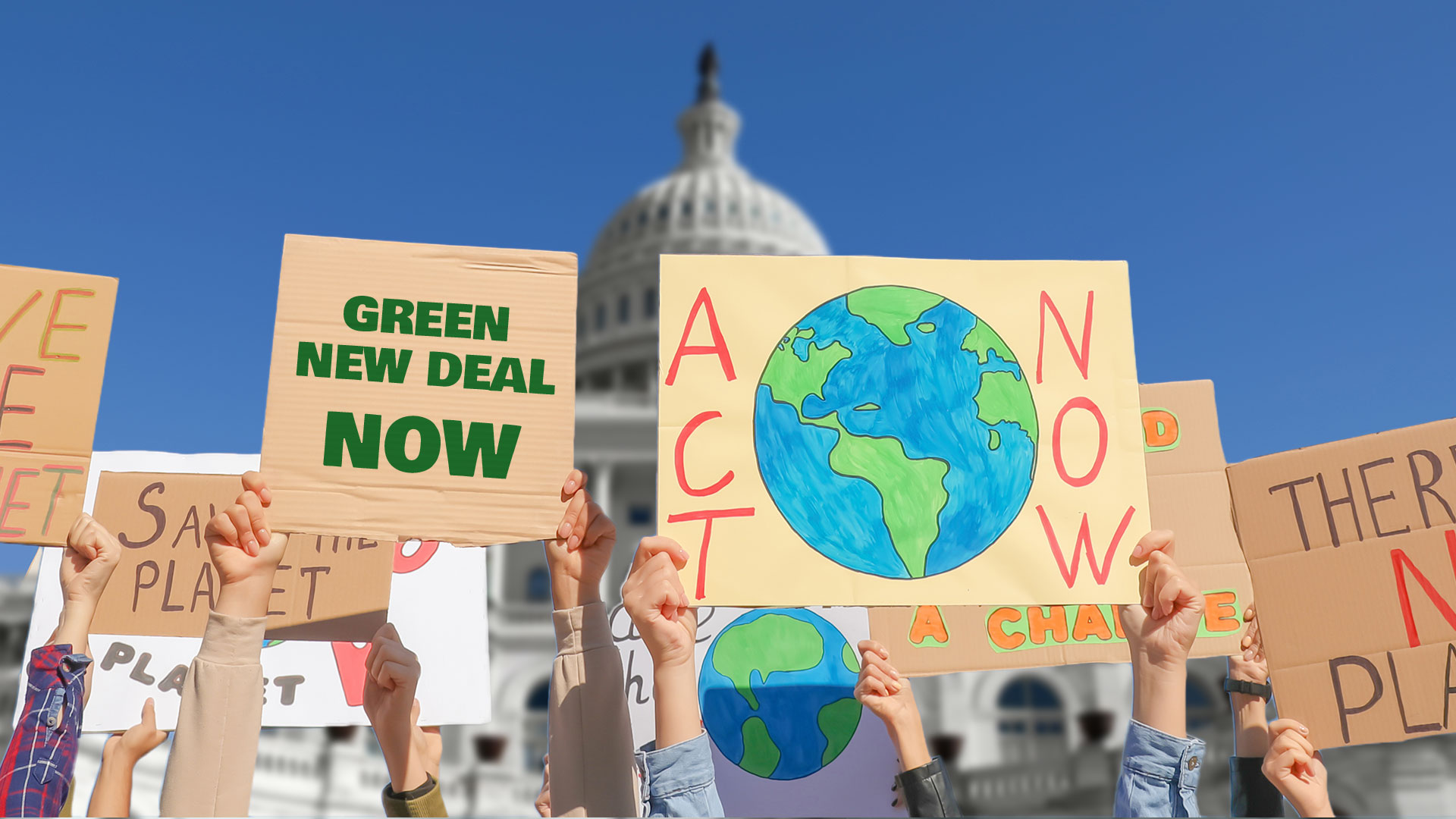Listen to the audio version >>
The Green New Deal from Below expresses the values and programs of the Green New Deal at local, state, and regional levels. But it is also a strategy for how to realize those values and implement those programs. This Strike! Commentary will explore how, in a complex and conflicted political arena, the Green New Deal movement has constructed such a strategy. The next commentary will explore how it has implemented that strategy in practice.

Adobe Stock By Kiattisak
The Green New Deal from Below represents a unique formation which therefore requires – and has developed — a unique strategy. It is not the same as an electoral campaign, a civil disobedience struggle, a neighborhood organization, a union recognition or contract campaign, an issue campaign, or other familiar forms of social action, though it may have similarities to all of them. It is necessary to recognize this uniqueness to avoid being caught up in familiar but inappropriate tactics.
If power were distributed equally in American society there might well be Green New Deals by now in a majority of American cities and states. But in reality, power is concentrated in the hands of a tiny minority – far smaller even than the notorious “1 percent.” Under normal circumstances the rest of the people have little influence over the basic decisions that determine our lives. The right to vote is precious, but it confers only limited influence over governments and even less over the corporations that shape economic decisions and in practice largely shape the policies of governments.
Yet ultimately the power of the powerful depends on the rest of us accepting and even enabling them. The withdrawal of our acquiescence and cooperation can render them powerless – as the old labor anthem goes, “Without our brain and muscle not a single wheel can turn.”
The problem of Green New Deal strategy is in essence how to organize and mobilize the potential power of the people. One way is to use the power that we have within existing institutional structures. But in a grossly unequal system, voting and other institutionalized forms of action are likely to have only limited impact. From its start, the Green New Deal has combined action within the political system with direct popular action in the streets – and, uninvited, in the halls of power.
The Anti-Green New Deal Forces

Those who believe they have an interest in perpetuating the burning of fossil fuels have created powerful obstacles to a Green New Deal. Fossil fuel industries and their allies use their wealth and political clout to resist climate protection policies. They spend millions on deceitful propaganda denying the reality of climate change. They advocate for false solutions that in fact do not reduce the greenhouse emissions that cause climate change. They engage in “greenwashing,” promoting policies and activities that they falsely claim are “pro-environmental.” They conduct environmental blackmail, threatening workers and communities with dire consequences if fossil fuel burning is restricted. They ally with “neoliberal” ideologists who oppose government climate action as impermissible interference with the “free market.” They collude with efforts to corrupt and undermine democracy, thereby restricting the power of the people – those who are the most threatened by climate change – to take effective measures to combat it.
Those who benefit from the inequality of American society also have a powerful incentive to fight the Green New Deal. They fear the redistribution of the good things of the earth from themselves to those less fortunate – whether that takes the form of taxing the rich, ending the super-exploitation of discriminated-against groups, or empowering workers to gain greater freedom on the job and a greater share of the wealth they create.
The anti-democratic control of American politics – the so-called “Democracy Deficit” – comes about in a variety of ways. Big money – and the freedom to use it to acquire political power – allows those who have it to dominate the political system. Popular political participation is repressed through gerrymandering, voter exclusion, and outright terrorism. US politics is built around individual candidates and officeholders, with little effective accountability of either politicians or parties to their electorates and their promises; electing candidates provides no guarantee of implementing the policies they purport to support.
The Republican Party has made a creed of opposition to climate protection – and of measures to reduce injustice and inequality. With occasional exceptions, this is true of the main forces within the Republican Party: the conservative business wing, the proto-fascist right wing, and the politically extremist religious wing. They have made the Green New Deal a poster child for everything they find threatening and objectionable.
Although a strong wing of the Democratic Party supports the Green New Deal, the party leadership has been reluctant either to advocate for the Green New Deal or to attack it directly. Instead, they have generally given some lip service to its aspirations, presented programs designed to coopt its support, and meanwhile kowtowed to corporate and fossil fuel interests, supported expansion of fossil fuel extraction, and acquiesced in a status quo of inequality and injustice. The right wing of the Democratic Party, exemplified by Senator Joe Manchin, has vigorously and often successfully opposed almost every aspect of the Green New Deal program.
Strategic Perspectives

So far, these forces have managed to block the Green New Deal at a national level. The strategy of the Green New Deal from Below is designed to outflank them.
The strategy of the Green New Deal from Below is often tacit. It is evidenced in the action of Green New Dealers, such as those described throughout this series of Commentaries on the Green New Deal from Below. It is tacit in part because it has developed as a response to the conditions people are facing as much as from a preexisting theory. And because the Green New Deal from Below has rarely been identified as an entity, neither participants nor observers have had much occasion to address questions about its overall development. But the main lines of that tacit strategy can be made explicit.
The strategy of the Green New Deal from Below is not a comprehensive strategy for social change. That requires means to transform basic structures of the national and world order including capitalism and the nation state system. The Green New Deal from Below can be part of that wider process of change, but it cannot subsume it.
Because of the fluidity of the current US political scene, the Green New Deal from Below of necessity presents a fluid strategy. How could it be otherwise in the era of the COVID pandemic, the rise, fall, and possible resurrection of Donald Trump, and the emergence of the Green New Deal itself?
The Green New Deal from Below is, in military terminology, an outflanking strategy. Blocked in the national arena, Green New Dealers have moved to sub-national arenas – hundreds of them. Here they are conducting hundreds of battles. Besides winning immediate benefits, these battles are building up the Green New Deal forces and weakening their opponents. While no single one of them is likely to be decisive nationally, cumulatively these battles can shift the balance of forces and open the way toward transformative breakthroughs.
There is still a role in this strategy for national action. It includes concentrating regional and national support for particular local struggles such as the El Paso climate referendum and the resistance to Gulf oil leases. It also involves national legislative proposals laying out Green New Deal programs for housing, healthcare, cities, and other aspects of the Green New Deal program. And it involves nationally coordinated demonstrations and other actions that show support for the Green New Deal and keep it in the public eye.
Despite its shift away from a national focus, the Green New Deal from Below retains many of the core elements of the original Green New Deal strategy. It presents an integrating program based on using climate necessity as the basis for labor and justice transformations. It brings diverse people together around that program. It organizes and mobilizes people to implement it. These elements are not sequential: they are synergistic, depending on each other.
From its inception the Green New Deal has been a fusion of action inside the institutional structure of representative democracy and of popular mobilization for direct action and civil disobedience. Indeed, it was initiated by the confluence of a civilly disobedient occupation of the office of the Democratic Party leader of the US House of Representatives and the initial legislative proposal for a Green New Deal presented by a newly elected member of Congress. This is a “pincers strategy” response to the inequality of power and the democracy deficit. Both Sunrise and Alexandra Ocasio-Cortez continue to advocate for – and practice — synthesizing action inside and outside “the system.”
The political strategy of the Green New Deal from Below exemplifies this confluence. It aims to capture governmental power – and more broadly institutional power. Legislators, mayors, and governors have been elected under its banner. At the same time, it has organized to lead and pressure politicians, institutions, and their leaders. It has organized people to act on their own in civil society – from neighborhoods creating their own solar gardens to unions establishing green training programs to coalitions blocking fossil fuel pipelines. And it has continued to use direct action and civil disobedience where politicians, governments, and corporations won’t stop destroying the planet and exacerbating injustice and inequality. While there are inevitably tensions among these various forms of action, institutional and noninstitutional forms of action have been increasingly intertwined in American politics.
While the focus of the Green New Deal and the Green New Deal from Below have been national and subnational, they interface with global issues in a variety of ways. One origin of the current Green New Deal was in an earlier Global Green New Deal. And today the Green New Deal is not just a local or even a national movement, but a global program being fought for in many countries around the world. Local Green New Deal initiatives are therefore also part of a wider effort to establish a just and sustainable world order. For example, California, Maine, Massachusetts, Oregon, Rhode Island, and Washington are also part of the global Under2 Coalition which brings together over 270 sub-national governments — representing 1.75 billion people and 50% of the global economy – to pursue climate protection policies.
The next Commentary in this series will explore the strategic objectives of the Green New Deal from Below and how they are being realized “on the ground.”

